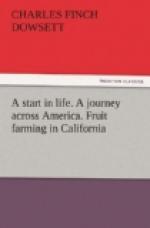On December 27th, about 5 o’clock in the morning, we began to clear out of the dock, and in a few hours were again on the broad Atlantic. The next day (Sunday, December 28th), we had service on board, conducted by the doctor in the saloon: all on board not actually on duty may attend. We left New York in a blizzard, and our decks were coated with frost and snow, but after two days this was all cleared away, and we had a splendid run in genial weather, so that one day I could comfortably walk on deck without a greatcoat.
Our run was—from Sandy Hook Lighthouse (45 miles) to noon of December 28th, 373 miles; noon of December 29th, 379 miles; December 30th, 375 miles; December 31st, 878 miles; January 1st, 1891, 372 miles; January 2nd, 362 miles; January 3rd, 371 miles; thence, to Queenstown, 169 miles; and from Queenstown to Liverpool, 240 miles; making a total of 3,064 miles. The passage in the “Etruria,” going out, was 3,062 miles. The “Servia” is a fine ship, but much older than the “Etruria,” and her engines, consequently, are not capable of the speed of a newer vessel. Her cargo capacity is 6,500 tons, with 1,800 tons of coal and 1,000 tons of water ballast. Her horse-power is equal to 10,500. The saloon is 74 by 49 feet, and is capable of seating 350 persons. The “Servia” has cabin accommodation for 500 saloon and 600 steerage passengers, besides a crew of 200 officers and men. When there are more than 350 saloon passengers, each meal has to be served in two relays.
An interesting incident occurred during the passage: I discovered that our captain (now commanding the “Aurania”) was a shipmate of mine in 1855, when I was a midshipman. I reached my office in Lincoln’s Inn Fields at 8 o’clock on the morning of January 5th, having been absent just about six weeks. The distances were as follows:—
Liverpool to New York 3,062 miles. New York to Chicago 913 " Chicago to Council Bluffs 488 " Council Bluffs to San Francisco 1,867 " San Francisco to Merced 152 " Merced to New Orleans 2,344 " New Orleans to Washington 1,144 " Washington to New York 228 " New York to Liverpool 3,064 " London to Liverpool 201 " Liverpool to London 201 " Journeys in buggies, tram-cars, &c. 110 " -------- 13,774 "
I must conclude with some general remarks:—
The Times recently published a series of ten articles on the “Negro Question in the United States,” and from them it appears that the position of that country is very serious in this relation. These articles commenced after I had started on my journey, so that I only saw one or two of the concluding ones and the Times leader upon the whole, but I was not surprised to see them, because in passing through the States which are principally peopled by negroes, I heard something about the matter from a thoughtful man, who regarded the subject with great gravity. The Times has shown that the attitude of one race to the other is that of “antagonism, discontent, and perpetual danger.”




